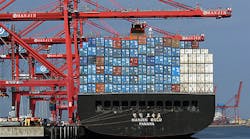Retailers and carriers have spent most of 2020 adapting to new and emerging needs of consumers while also shifting business models to handle the economic impact of a global pandemic. E-commerce quickly transformed from a convenience to an urgent necessity. In fact, even in September, as the stay-at-home orders of spring and early summer felt like a distant memory, 28% of US consumers still said they were shopping online more than before the pandemic, according to the EY Future Consumer Index (FCI).
Now with just weeks to go before the traditional holiday shopping boom, fewer people are expected to be fulfilling their holiday wish lists in stores. Retailers are trying to capture the digital demand by building trust with consumers, and one way to do this is by working collaboratively with carriers to mitigate constraints and avoid late or missed deliveries. But according to the FCI, only 21% of US consumers report forgiving brands and stores whose service has been disrupted by COVID-19, making it even more critical to deliver on schedule.
Keeping a collaborative mindset
The effort to devise a plan that accurately forecasts demand and capacity patterns in each market has never been easy, and projecting shipping volumes is different this year, as volume is already hitting all-time highs in virtually every market. With other unpredictable events on the horizon, such as winter snowstorms and the US Presidential election to upend consumer behavior, collaboration between retailers and carriers will be essential to tackle the shipping constraints that will surely exist.
To quell holiday shopping volume, retailers have been flattening the curve and creating early momentum heading into the year-end rush. This also helps carriers by spreading out shipping volume across the heart of the holiday shopping season. When it comes to working together more strategically, both sides should consider:
- Taking steps to strategically distribute volume and position inventory further down in the supply chain
- Implementing technology solutions to mitigate real-time challenges and forecast supply chain ebbs and flows
- Working together to understand cost drivers — and push to slower deliveries or underutilized network lanes
- Finding capacity that doesn’t add material cost to carriers
- Discussing timing for surge rates and agree on no surge before Thanksgiving, with higher rates after the holiday
- Considering nontraditional partnerships with entities such as app-based delivery services, leveraging the gig economy to harness untapped capacity for last-mile delivery; it’s a next-level solution, yes, but one that should be considered in these unprecedented times
- Asking consumers to opt for a consolidated delivery day or provide a discount for picking up at a central location, such as a pickup locker, to reduce the number and range of stops a carrier is asked to accommodate, creating synthetic density in the supply chain
Synthetic density is a tool whose value may require both time and experience for customers to fully appreciate. For instance, take a customer who is reluctant to retrieve their package at a pickup locker. If that method proves to be the only viable option to get the package delivered before Christmas due to heavy volume with the traditional shipping channels, it may gain in consumer acceptance. The best way to maintain customer satisfaction is to create a system that offers a variety of options that meet the demand for both convenience and, when it’s needed, urgency.
It is also imperative for logistics companies to embrace collaborative technologies for greater visibility and supply chain efficiency, and ultimately to achieve higher profitability. A few examples of such technologies include use of digital technologies to enable carriers to choose and schedule their deliveries and data analytics to help shippers stay connected in the transportation network and match demand with available carrier capacity. Such technologies can also help in addressing idle time of carriers by use of dock scheduling, a process that allows carriers to self-schedule at preferred arrival times.
Financial boost doesn’t solve short-term capacity problem
Carriers have invested billions of dollars to boost capacity and strengthen the supply chain in anticipation of online buying, and we have learned how crucial these shipping channels are to maintain the framework of a functional society. Catalyzed by COVID-19, carriers have been able to improve yield and finally see a return on their infrastructure investment. However, the last stop in the distribution change now extends to the consumer’s doorstep, making last-mile delivery more competitive than ever. And with the exponential increase in e-commerce, retailers are struggling to give accurate projections of volume to their carriers.
Despite the financial improvement for carriers, there is lingering anxiety about the network’s capability to grow and absorb increased demand and to deliver goods to rural residential locations. If rate increases stay in place long term, it may result in fundamental changes that build capacity. With the holiday season inching closer, the ideal scenario would be to also build momentum and identify strategies that can mitigate short-term concerns while concurrently laying the groundwork for a more robust e-commerce network. Contingency plans of all types are a wise investment, even if they never end up needing to be implemented.
If 2020 has proven anything, it’s that few things ever go according to plan. In a time of never-ending uncertainty, the key to getting through any of these challenges will be keeping the lines of communication open and being ready to adjust at a moment’s notice through a collaborative mindset.
Kevin Custis is the EY Global Transportation leader. The views reflected in this article are those of the author and do not necessarily reflect the views of Ernst & Young LLP or other members of the global EY organization



